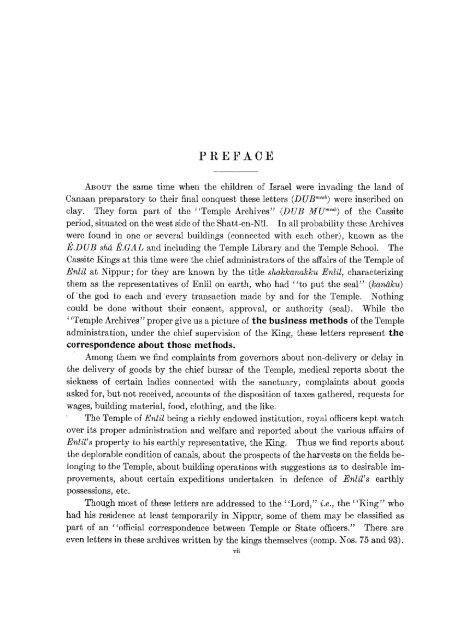THE BABYLONIAN EXPEDITION
THE BABYLONIAN EXPEDITION
THE BABYLONIAN EXPEDITION
You also want an ePaper? Increase the reach of your titles
YUMPU automatically turns print PDFs into web optimized ePapers that Google loves.
PREFACE<br />
ABOUT the same time when the children of Israel were invading the land of<br />
Canaan preparatory to their final conquest these letters were inscribed on<br />
clay. They form part of the "Temple Archives" (DUB MUm"") of the Cassite<br />
period, situated on the west side of the Shatt-en-Ntl. In all probability these Archives<br />
were found in one or several buildings (connected with each other), known as the<br />
A DUB sh6 O.GAL and including the Temple Library and the Temple School. The<br />
Cassite Kings at this time were the chief administrators of the affairs of the Temple of<br />
Enlil at Nippur; for they are known by the title shakkanakku Enlil, characterizing<br />
them as the representatives of Enlil on earth, who had "to put the seal" (kanhku)<br />
of 'the god to each and 'every transaction made by and for the Temple. Nothing<br />
could be done without their consent, approval, or authority (seal). While the<br />
"Temple Archives" proper give us a picture of the business methods of the Temple<br />
administration, under the chief supervision of the King, these letters represent the<br />
correspondence about those met hods.<br />
Among them we find complaints from governors about non-delivery or delay in<br />
the delivery of goods by the chief bursar of the Temple, medical reports about the<br />
sickness of certain ladies connected with the sanctuary, complaints about goods<br />
asked for, but not received, accounts of the disposition of taxes gathered, requests for<br />
wages, building material, food, clothing, and the like.<br />
The Temple of Enlil being a richly endowed institution, royal officers kept watch<br />
over its proper administration and welfare and reported about the various affairs of<br />
Enlil's property to his earthly representative, the King. Thus we find reports about<br />
the deplorable condition of canals, about the prospects of the harvests on the fields be-<br />
longing to the Temple, about building operations with suggestions as to desirable im-<br />
provements, about certain expeditions undertaken in defence of Enlil's earthly<br />
possessions, etc.<br />
Though most of these letters are addressed to the "Lord," i.e., the "King" who<br />
had his residence at least temporarily in Nippur, some of them may be classified as<br />
part of an "official correspondence between Temple or State officers." There are<br />
even letters in these archives written by the kings themselves (comp. Nos. 75 and 93).<br />
vii

















